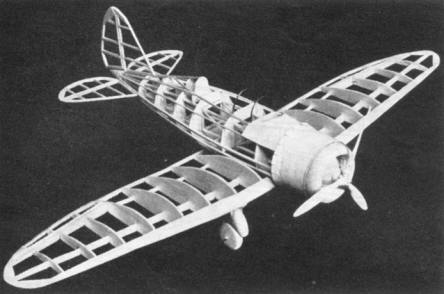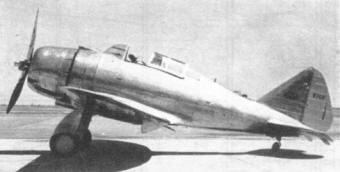|
Here is a sleek, well-known ship famous by PAUL W. LINDBERGModel Editor and Designer A SEVERSKY RUBBER-POWERED MODEL
MOST model builders are familiar with the name of Seversky and we know that you will be proud to own an exact scale model of the ship that won the 1938 Bendix Trophy Race. (Also see page 10.) There is plenty of pep in this model and plans are drawn full size but if you so desire, they may be enlarged two times in order to give a better flying model. All details have been carefully worked out on the plan and if strictly adhered to, you will find very little difficulty in building this excellent model. Construction of Fuselage Constructing the fuselage is simple if the following steps are taken. First, place a sheet of waxed paper over the plan so that none of the parts will stick to same. In building the rectangular fuselage, build the two sides and cement these together with cross members of 1/16" square hard balsa. All formers are cut from 1/32" balsa wood. Cut these to the various shapes as shown in template on the plan. In cementing these in their respective positions to the fuselage, make sure all projecting edges are sanded down smooth so that the stringers will be in a more streamlined form on the body. The stringers are made from 1/32" by 1/16" hard balsa and are cemented to the formers as clearly shown on plan. The front part of cowl is turned from a piece of solid balsa. Remaining part is of one piece of stiff paper cemented together at bottom. Motor construction is shown in detail. Give these parts a great deal of time as you will be well rewarded in the finished effects of your model. Construction of Wings Construct these upon a flat surface after first placing a sheet of wax paper upon the plan. All ribs are cut to form with templates shown on plan. After the two halves are completed, they are cemented together at their centers. No additional bracing is required other than shown on plan due to the great number of ribs which give it ample strength. Movable ailerons may, or may not be built into the panel but we highly recommend these to take care of the propeller torque when model is flown. Aluminum inserts are used for hinges. Building the Elevator and Rudder These two are of movable type but may be built otherwise if desired. One-sixteenth-inch square is used in the construction throughout, with the exception of the trailing edges for both elevator and rudder which are of 1/16" sheet balsa. We might add here that rudder and elevator are to be covered with tissue before cementing them to the fuselage. In cementing these to the fuselage, brace thoroughly so that no flabby motion is had while model is in flight. Construction of Landing Gear and Other Details The landing gear is of the fixed type and cannot be retracted. Solid soft balsa fairings are used throughout. If no streamlined wheels are available, a pair of balsa wheels turned up on any ordinary lathe will serve the purpose. Two types of propellers are shown. One scale prop which is to he used only for exhibitional purposes. The flying propeller has, as you will note, much more blade area which is sufficient to fly the model. We recommend six strands of 1/8" flat rubber in flying this model. Ordinary Japanese tissue is used in covering. Do not attempt to cover the body in too wide pieces. We suggest one stringer space at a time. After all parts are covered, apply a light coat of water. This will shrink the tissue up lightly so that the coats of clear dope may be added. Color scheme for this model is all silver with black details. Testing and Flying the Model Launch the model gently from your hand in a slight downward angle. If model should rise abruptly with nose up, weight should he added to the bottom part of front of cowl. If the revere happens, add weight to the tail. END Scanned From March, 1939 |

